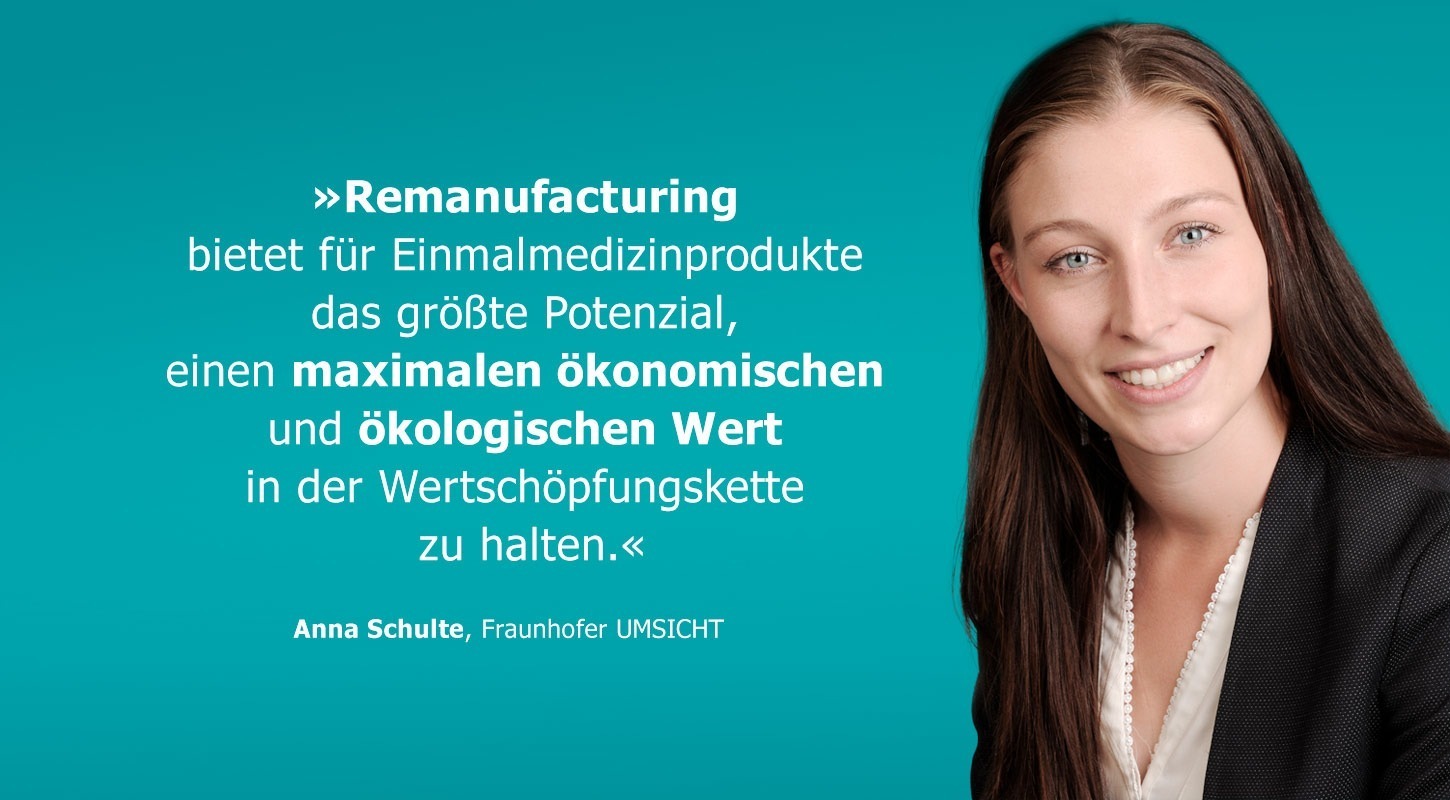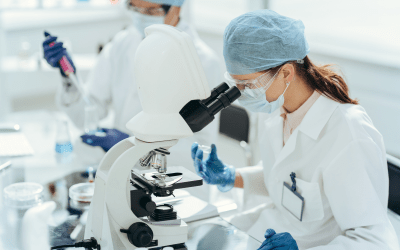Enabling Circular Economy through Medical Remanufacturing
Vanguard has set itself the goal of enabling the circular economy through medical remanufacturing. In the study “Combining Life Cycle Assessment and Circularity Assessment to Analyse Environmental Impacts of the Medical Remanufacturing of Electrophysiology Catheters”, Fraunhofer UMSICHT compared the new production of a catheter with a catheter remanufactured by Vanguard with regard to their impact on global warming as well as their resource consumption. We asked Anna Schulte, author of the study, what contribution medical remanufacturing can make towards the transition to a sustainable healthcare system.
Please tell us something about Fraunhofer UMSICHT.
Fraunhofer UMSICHT, one of 74 Fraunhofer institutes, is headquartered in Oberhausen, with a branch in Sulzbach-Rosenberg (Bavaria) and a plastics technology centre in Willich. As an institute of the Fraunhofer-Gesellschaft, we are networked worldwide and promote international cooperation.
What are the goals of Fraunhofer Umsicht?
The transformation to a sustainable and climate-neutral economic system requires responsibility, great commitment and the cooperation of all social groups. Fraunhofer UMSICHT is a pioneer in a sustainable world, provides scientific results and transfers them to companies, society and politics. We want to make our research understandable and motivate people to join us in the transition to a sustainable society.
What are the research areas and topics of Fraunhofer UMSICHT?
Together with its partners, the institute researches and develops climate-neutral energy systems, resource-efficient processes and circular products that contribute to achieving the 17 Sustainable Development Goals (SDGs) of the United Nations. We are working hard to bring knowledge, methods, technologies, products and services in the business areas of polymer materials, chemistry, environment, biomass and energy to application maturity.
In which field do you work?
I am part of the sustainability assessment team at Fraunhofer UMSICHT (Department of Sustainability and Participation) and deal, for example, with methods for recording and evaluating products and technologies in terms of their environmental impact. This is how we contribute to sustainable development. The aim is to combine knowledge to support people, resources and technologies with modern management tools in a sustainable way.
What scientific methods do you use for this?
Our methods are sustainability assessments, life cycle assessment, material flow and energy balances, stakeholder involvement, design thinking, digital manufacturing and technology scouting. In our projects, we develop for example, climate protection strategies, product optimisation over the entire life cycle or circular economy concepts.
What is your professional focus?
My personal focus is on the Circular Economy, especially for plastic products and materials. I am currently doing research in the Cluster of Excellence: Circular Plastics Economy (CCPE), in which six Fraunhofer institutes are working together to make the plastics value chain more circular. The aim of the cluster is to extract fewer fossil resources, to design products intelligently and use them for a long time, and to reduce end-of-life losses. In this context, methods for recording and evaluating the environmental impacts of products and materials in relation to the Circular Economy are of significant importance in order to ensure the sustainable implementation of Circular Economy strategies, such as medical remanufacturing.
If you want to learn more about our research focus, you can meet some of our thoughtful trailblazers into a sustainable world in this video:
In your view, how important is the circular economy for achieving climate goals?
The transformation towards a circular economy, which aims to minimise primary resource use, waste production and emissions, is an important guiding principle and key element in achieving the United Nations’ Global Sustainability Goals (SDGs).
Climate protection is one of these goals to which a Circular Economy can contribute. Furthermore, a circular economy also has the potential to contribute to sustainable consumption and production. A Circular Economy is a theoretical concept that aims to decouple economic growth from the consumption of finite resources in order to keep materials and products in circulation at all times at their highest possible use and value.
In reality, however, we need to find resilient examples that contribute to climate protection and reduce resource extraction through circular value creation.
What contribution does medical remanufacturing make to the health sector in this context?
Our study has shown that medical remanufacturing can make a significant contribution in both categories compared to new production. Compared to using a newly produced electrophysiology catheter, using a catheter from medical remanufacturing can reduce the contribution to global warming by about half (50.4%). This means that medical remanufacturing can contribute to climate protection and the saving of primary resources while also generating financial savings.
The process is a great example of how the transformation towards a circular economy can succeed. In a further modelling over several life cycles, we were able to estimate in the study that approx. 450,000 t kg CO2-eq. could be saved annually in Germany.
What are the differences between recycling and medical remanufacturing of single-use medical devices?
Currently, recycling is still the focus of discussions about the Circular Economy. However, in most cases this is actually the least profitable option – both economically and ecologically.
Can you explain this in more detail?
The Circular Economy is about preserving value. This conservation of value is achieved by returning products after their use to their highest possible value and benefit.
In recycling, only the value of the material is preserved, e.g. the value of a plastic made from recycled material.
Medical remanufacturing on the other hand involves the remanufacturing of a product, which must have the same requirements and the same quality as a virgin product. Medical remanufacturing preserves the value of the product, in this case the value of an electrophysiology catheter, which is significantly higher than the value of the recycled material.
This is not only about the economic value that is preserved, but also about the ecological value. If recycling and producing products from recycled materials consumes more energy than remanufacturing, a greater ecological value is attained.
In addition, high-performance polymers are often used in medical devices, i.e. complex plastics that are not of significant importance in municipal recycling. Direct reuse without reprocessing, is not an option, as patient safety is the primary concern with medical devices.
Medical remanufacturing for single-use medical products offers the greatest potential to retain the maximum economic and ecological value in the value chain from a circular economy perspective.
What makes the study “Combining Life Cycle Assessment and Circularity Assessment to Analyse Environmental Impacts of the Medical Remanufacturing of Electrophysiology Catheters” particularly interesting from your point of view?
In our research, we were unable to identify any studies that explicitly address the environmental impacts of medical remanufacturing of medical devices, although there are studies that clearly identify the potential.
In addition, we looked not only at the environmental impacts of using a remanufactured catheter compared to using a catheter made from virgin material, but also at the circularity of this strategy and what environmental impacts arise from it in a systems perspective.
We were able to show that the environmental savings per catheter increase with the number of remanufacturing cycles. This means that the more catheters are collected and remanufactured, the higher the savings per catheter will be.
What is Fraunhofer Umsicht UMSICHT currently researching and what topics can we expect in 2021?
The topic of the Circular Economy is of ongoing interest for our organisation.
Amongst other things, we are continuing our research into making the plastics value chain more circular. The problem is not the plastic, but how we deal with it. Plastic products are part of modern society, offer excellent properties but are often durable materials that can remain in the environment for hundreds of years in case of improper disposal. Appropriate technologies, materials and processes will be able to adress this.
Thank you for the interview.
More informationen about Fraunhofer UMSICHT
>> Sustainability and Participation Department
>> Fraunhofer-Cluster CCPE




